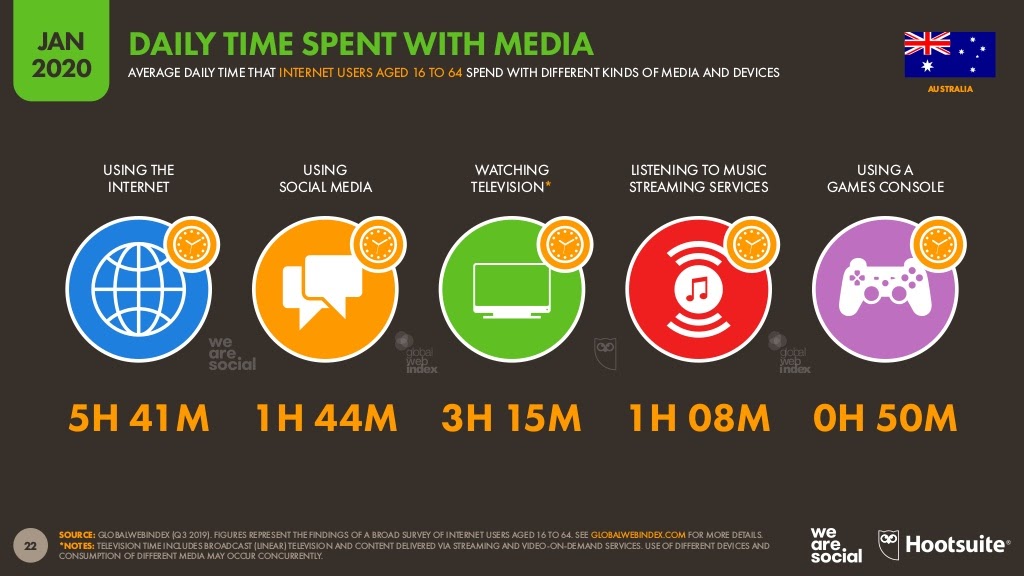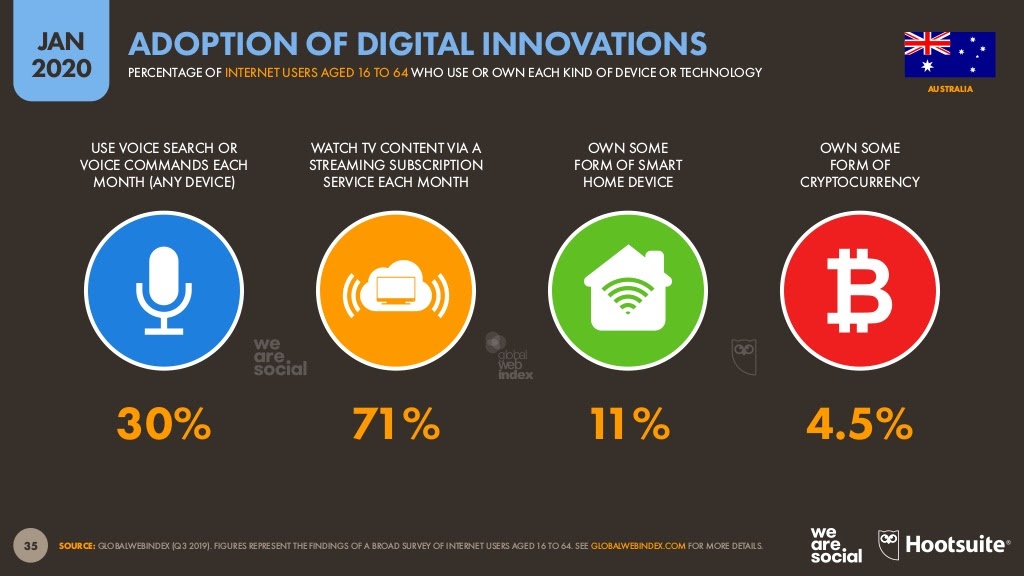Australia is the smallest continent and one of the largest countries in the world. It comprises the Australian continent, Tasmania, and other smaller islands. The nation is also known for its wealthy underpopulated demographic, fantastic natural wonders, and most notable for being geographically isolated from the rest of the globe.
The English-speaking nation is a highly developed, high-income country and is the world’s 14th largest economy. According to the International Monetary Fund (IMF), the nation has the world’s 21st-highest per capita income. Furthermore, it is considered as a melting pot of various cultures as 22% of its population are immigrants, making it the 9th largest immigrant population in the world. More representations of its progressiveness are shown through having the third-highest human development index and high rank in terms of quality of life, health, education, economic freedom, civil liberties, and political rights.
The digital side of the business industry in Australia is thriving as businesses spend more on digital media ads than ever before, and this is expected to continue increasing over the coming years. With the booming e-commerce industry and fast adoption of smart technologies, the digital landscape in the country presents space for more growth and promising opportunities for marketers.
Australia’s Online Landscape
Australia has experienced incremental growth over the past years. However, We Are Social and Hootsuite’s recent collection of global digital reports show that the number of Australian internet users has increased by 1% since January last year, with a penetration rate of 88%.
Despite this, social media use remains prevalent. As of January 2020, the number of active social media users in the country has seen an increase of +4.3%. Out of the 25 million population, this translates to 18 million active social media users, with a penetration rate of 71%.

Source: https://wearesocial.com/au/digital-2020-australia
Australian online users spend an average of 5 hours and 41 minutes daily on the internet, or a frequency rate of 93%, and approximately an hour and 44 minutes on social media. Daily internet time consumption has increased by 37 minutes since last year. Social media use has also seen an increase in this aspect but with only 13 minutes added.

Source: https://wearesocial.com/au/digital-2020-australia
The report also shows that Australian internet users are well into adopting new technologies. 30% of users use voice search or voice commands, which means that people will soon no longer be seeing pages of search results, but only a few generated by their voice assistant. It is expected that voice search will continue to grow over the years and disrupt the search landscape.

Source: https://wearesocial.com/au/digital-2020-australia
Digital advertising is something that incites initial resistance from Australian users. In fact, 46% of the entire Australian internet population use ad blocking tools and as much as two in five opt not to see any digital ads within 30 days. This is reflected in the growing number of subscriptions for online streaming services such as Netflix.
Recent studies also show that Australia has the lowest click-through rates for banner ads in the world. However, recent consumer studies show that there is an 82% preference for tailored, targeted advertising.
An estimated 40% of all Australians believe that advertisements should acknowledge the COVID-19 pandemic, according to the latest Dynata research.
Thus, marketers must focus on devising precise and addressable marketing strategies.

Source: https://wearesocial.com/au/digital-2020-australia
Online shopping has been a flourishing industry in Australia and has experienced growth across all metrics. It has also had a +12% year-on-year increase on the value of consumer goods in the e-commerce market, which is currently worth US$26.50 billion.
According to the We Are Social’s report, people searching for products and services are at 84%, people visiting stores at 76%, people making online purchases at 70% via both desktop (47%) and mobile (33%).

Source: https://wearesocial.com/au/digital-2020-australia
These data show that Australians are comfortable with online shopping, be it mobile, desktop, or social. As such, marketers may consider it high time to delve into social shopping for their brand.
Biggest Channels

Source: https://wearesocial.com/au/digital-2020-australia
According to the Yellow Social Media Report 2020 by Sensis, over 80% of the Australian internet population access social media sites, with one-third doing so five times a day, and 79% going on social media daily. The report also showed that 8 out of 10 Australian users see social media as a way to communicate with family and friends, with 39% saying that they use it for sharing content such as photos and videos.
Facebook remains as the most popular social platform and networking site with 89% of the internet population maintaining a Facebook account or approximately 19 million users. The site’s appeal appears to be dominant among all places in Australia. In 2020, the report showed that Facebook is the preferred platform for SMBs and large businesses advertising, followed by Instagram at 22% of large businesses.
Taking the second spot as the most preferred social media channel is YouTube, watched by 54% of all Australian users. Last year, it was found that the site attracted more male users than female. However, unlike Facebook, YouTube receives more traction in New South Wales, Victoria, and around metropolitan areas.
For messaging apps, Facebook Messenger dominates with 65% of Australian online users. Far behind are WhatsApp at 33% and Viber at a mere 10%.
Other popular social media sites are Instagram, which has had a steady growth of +4.3% since last year, and Snapchat, which has also experienced a recent increase of nearly +3.8% in terms of quarter-on-quarter growth of advertising reach. In contrast, the site which has seen the biggest dip during the past quarter is Twitter, with a -3.3% decrease in quarter-on-quarter growth in advertising reach.
Trends and Opportunities
Voice Search
Research shows that 56% of adults feel tech-savvy when using voice search. In Australia, approximately 57% of adults use voice search, and it is estimated that the voice recognition industry will be worth over US$26 billion by 2025. Over 5.7 million Australians currently have a smart speaker system in their households, that is 22% of Australia’s entire population.
The rise of voice-based assistants is perceived to disrupt the search landscape, which begs the need for marketers to integrate this into their digital marketing strategies as soon as possible. With voice search, consumers no longer have to sift through pages of results; voice assistants will only generate one or two of the top results.
Additionally, it is expected that this will also mean lesser screen time. Thus, brands, along with the production of more audio content, must pair voice search with a good SEO strategy to ensure continued brand awareness among its target audience.
Furthermore, the structure of content will also change to a more conversational tone; therefore, keywords should also be tailored to what people would usually say in conversation, instead of basing them off the traditional typed keyword results.
The voice search industry might also expand to offering ad spaces in the near future. One blog even puts it that voice assistants like Alexa might soon answer questions along with a “reminder from her sponsor.”
Augmented Reality (Product Placement in Real Time)


Source: https://www.paypalobjects.com/marketing/brc/au/paypal-2020-ecommerce-index.pdf
Australia has a thriving e-commerce industry, which means that its consumers are also particular when making purchasing online. A 2020 research from PayPal suggests that 31% of Australians say that they are “on a budget but still spend on little luxuries that make them and their loved ones feel good.”
PayPal’s research also shows that Australians are more likely to purchase online if they could virtually see what an item will look like on them. This would reduce the number of product returns and would make the shopping experience more enjoyable. Augmented reality is also very helpful for conducting testing placement of heavier items such as furniture, décor, and equipment.
As eMarketer puts it, AR essentially helps marketers develop strategies that meet their audience’s specific needs for information, convenience, and entertainment, thereby improving customer experience.
Social Media Marketing
As previously mentioned, social media usage is very much an important aspect of the Australian online landscape. According to the Yellow Social Media Report 2020 by Sensis, over 80% of the Australian internet population access social media sites, with one-third doing so five times a day, and 79% going on social media daily. Additionally, 33% said that they first check a brand’s social media presence before making a purchase. Furthermore, more than 50% of Australian social media users said that they are most likely to subscribe to a brand if they engage positively with the consumer on social media, create relevant content, and update frequently.
However, social media advertising has seen more negative than positive reaction from the Australian audience, leading the country to have the lowest click-through rates for banner ads in the world. In 2018, only one in three users occasionally clicked on ads they encountered on social media, while more than one out of five said that they were quite happy seeing the presence of these ads.
Furthermore, the 2020 Yellow Social Media Report suggests 23 percent of Australian consumers like sponsored posts from businesses they follow on social media. However, only 53% agree that they ignore sponsored posts from businesses they don’t follow, with only 15% disagreeing.
Although quite difficult, marketers may still penetrate the Australian market through constantly improving customer engagement and experience, paired with creating relevant content.
Mobile Marketing
According to We Are Social’s recent global report, mobile phones are the most popular devices in Australia with 94% of the adult population owning one. With this comes geofencing, a location-based service that uses GPS, RFID, Wi-Fi or cellular data to trigger specific communications to prospective customers that enter or exit a particular area with a virtual boundary. For instance, a customer who has downloaded your app may receive mobile alerts once they are in the vicinity of the geofence you have set up in your business.
This technology has many uses for marketers, such as audience engagement, social networking, and even O2O marketing. Apps that use location-based filters and stickers, such as Snapchat, use geofencing to enable these features. In a concert, geofencing can be used to gather related social media posts and further promote the event. It can also be used to deliver push notifications, in-store promotions, and ads targeted to specific audiences which in turn help marketers develop better personalized customer experiences. Additionally, geofencing can also be a tool for consumer analytics.
However, marketers should be transparent with their customers about having access to their location-based data in order to encourage their trust and continued engagement with the business.
Chatbots
Chatbots are the current norm in improving customer experience and engagement. This AI-driven technology offers businesses a way to provide real-time customer support 24/7, reducing call wait time for customers, which in turn can increase overall customer satisfaction. Customers can immediately voice out their concerns and get simple issues solved quicker, which also shows customer care. Additionally, customers may be able to directly purchase from your website because of the immediate response from an AI.
Brands can leverage chatbots to gain important insights through their post-feedback and also as part of customer analytics.
Using chatbots as part of your multi-channel strategy is an ingenious way of expanding your reach while maintaining engagement. Marketers must choose the right channels to integrate a chatbot in as customers have different preferences depending on the type of products or services they may search.
Influencer Marketing
Survey results for The State of Influencer Marketing and Social Media in Australia report by The Exposure Co., showed that 40% of Australians are more likely to purchase from a brand they see an influencer posting about it.
Influencers can definitely help increase brand awareness and create an invaluable connection with your target audience. However, it is crucial that marketers must select the right influencer who best fits the campaign or brand value. The influencer does not have to be a huge celebrity; micro influencers who already have a loyal following that overlaps your company’s target demographic will be equally effective or even more so. It is even recommended to use micro-influencer for a groundswell approach and for building brand awareness, especially if working with a limited budget.
In fact, this is what automotive brand MINI Australia did to launch the new model of its new MINI convertible. In partnership with Vogue Australia, they collaborated with five fashion micro-influencers to help build brand awareness around the stylish features of the car. These influencers were then asked to test-drive the product, and then provide their thoughts, comments, and favorite features of the convertible through a series of Instagram posts.

Source: https://blog.scrunch.com/case-study-mini-australia
As a result, the campaign reached nearly 148,000 consumers, with 8,319 engagements with the campaign content.
Summary
Australia’s online landscape revolves around the realm of social media and internet-enabled devices. For digital marketers wishing to enter the Australian market, it is important to know that with the country’s large geography, different channels and trends accompany each city. Some of the best marketing strategies to base on are AI integration—such as AR, chatbots, and smart speakers—geofencing, influencer marketing, and good old social media marketing. With knowing the target audience well and the best ways to reach them, these trends may help brands devise the most effective strategies.
Contact us at Info Cubic Japan today to learn more about online marketing in Australia.
Featured Photo by Corey Smith on Pexels

